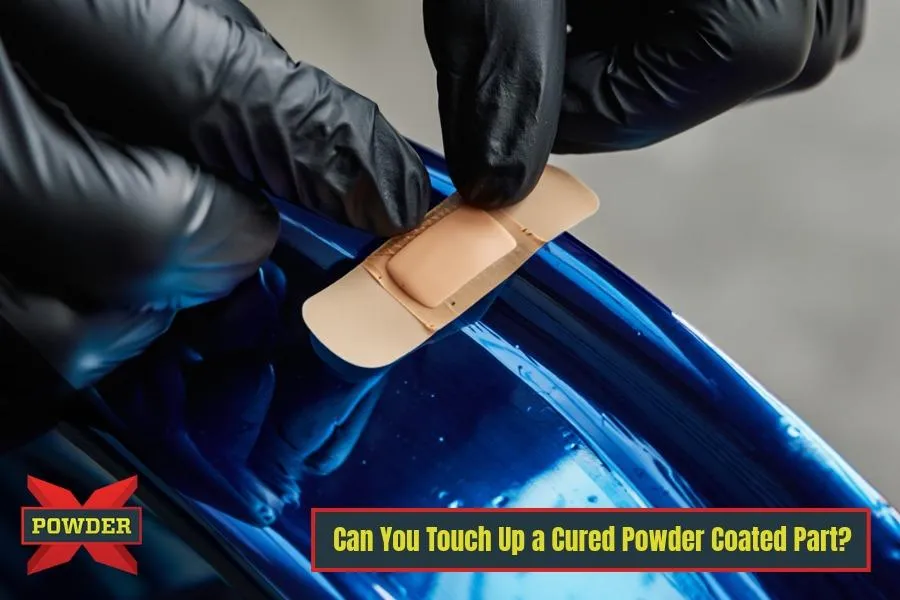
Can You Touch Up a Cured Powder Coated Part?
Yes, But Here’s What the Pros Know That Most Don’t
Let’s set the record straight. You’ve got a part that’s been powder coated, it’s cured, and now it has a scratch, nick, or imperfection. Naturally, the first question that pops up is: “How can I touch this up without stripping the whole part and starting over?” Understanding how to touch up powder-coated parts can be essential in addressing these issues effectively.
The short answer: Yes, but only if you do it right.
The long answer? That’s where most coaters go wrong, and it’s why I’m here to walk you through the right way, the smart way, and the profitable way to handle it.
First, Understand the Nature of Powder Coating
Powder coating isn’t paint. Once it’s cured, it doesn’t re-melt, and it doesn’t “blend” the way liquid coatings do. That’s the difference between baking a cake and slathering on frosting. Once the cake is out of the oven, you can’t go back and stir in more flour, but you can fix the finish if you know how to touch up powder coated parts.
This cured, hardened surface is chemically cross-linked, it’s durable, scratch-resistant, and weather-tough. But that also means any attempt to “touch it up” the wrong way can create a visual mismatch, adhesion failure, or worse, a failed part in the field.
Three Legitimate Options for Touch-Ups
Depending on the situation, budget, appearance expectations, and type of defect, touching up powder-coated parts can be done with a few tools in your toolbox.
1. Spot Touch-Up with Liquid Paint
This is the most common, and let’s be honest, the easiest route for learning how to touch up powder coated parts.
Pros: Fast, cost-effective, and can be done in the field.
Cons: Different gloss levels, texture mismatch, and lower durability.
Use this for small scratches or areas that won’t be exposed to extreme elements. A compatible liquid paint (like an epoxy or urethane-based paint) can give you decent protection and color blending. But it’s still a Band-Aid, not surgery.
Pro Tip: Use a fine artist brush and apply in very thin coats. Build up slowly. Rushing this will cause runs or noticeable bumps.
2. Localized Re-Coating with a Powder Gun (aka Spot Coating)
This is a more advanced move, but one that separates the pros from the hobbyists.
Pros: Stronger finish, better durability, excellent for larger areas or corners.
Cons: Requires re-heating and risks overbaking the base layer.
You can mask off the area, re-spray with powder, and re-bake. But here’s the kicker: If you’re not careful, you’ll reflow the surrounding powder and alter the original finish. That’s a fast track to a “halo” or orange peel disaster.
Joey’s Take: Use a heat gun instead of a full oven bake if the area is small. You’ll activate the new powder without compromising the cured surface around it. But be precise with your temps, too little, and it won’t flow; too much, and you’re back to stripping the part. Understanding the intricacies of how to touch up powder-coated parts like this can save you time and resources.
3. Complete Strip and Re-Coat (When Touch-Up Isn’t Worth the Risk)
Sometimes, the damage is too large or in a highly visible spot (like the face of a wheel or architectural feature). In those cases, it’s worth the time to sandblast and start over.
Pros: Total color and finish consistency, professional-grade result.
Cons: Time, labor, and material cost.
But here’s the opportunity: upsell the customer on a premium powder, multi-coat finish, or new color option. Turn a problem into profit.
Joey’s Real Talk: Know When to Walk Away
I’ve trained over 20,000 powder coaters around the world. Here’s what I tell every one of them:
“Just because you can doesn’t mean you should.”
The wrong touch-up can wreck your reputation. Know the chemistry, know the limitations, and always ask yourself: Is this the best long-term solution for my customer AND my business?
Common Mistakes to Avoid
Touching up with rattle-can paint without degreasing or scuffing the area first.
Over-curing during spot repairs, remember, powder won’t “blend” if it’s already cured.
Mismatching gloss levels (flat vs. gloss looks awful).
Skipping pretreatment, even for touch-ups, you need adhesion.
Final Word: Build a Reputation on Quality, Not Quick Fixes
Touch-ups should be part of your toolkit, not your fallback. Every job is a billboard for your business. Do it the right way, learning how to touch up powder coated parts properly, every time, and your shop’s name will become synonymous with quality.
And remember: Powder-X Coating Systems has your back with equipment, training, and real-world support from experts who actually know how to powder coats, not just sell equipment.
